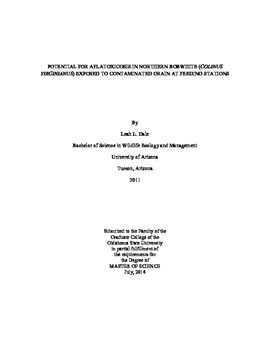| dc.description.abstract | There is concern about the potential impacts that supplemental feeding may have on wildlife populations. Possible negative effects of wildlife feeding include altered fecundity, recruitment, survival, predation, pathogen transmission, and exposure to aflatoxins through contaminated grain. Aflatoxins are produced by toxigenic strains of Aspergillus flavus and A. parasiticus and are considered the most toxic of all naturally occurring mycotoxins. Wildlife may be exposed to aflatoxins in agricultural grains during supplemental feeding and baiting practices. Although most supplemental feeding stations are designed to benefit white-tailed deer (Odocoileus virginianus), non-target species also visit bait stations leading to potential exposure to aflatoxins in contaminated grain. This is a particular concern for Northern Bobwhite (Colinus virginianus), a species in decline rangewide that has been demonstrated to be highly susceptible to aflatoxicosis. We used infrared-triggered cameras to assess non-target species visitation and potential for contact with aflatoxin at bait stations on the Cross Timbers Experimental Range in Payne County, OK in September 2012 and January 2013. Six species of birds and 10 species of mammals were photographed during the September survey. Species richness was higher during the January survey, with 17 bird species and 9 mammal species. Visitation increased from 1 non-target capture per hour in the fall to 2 non-target captures per hour in the winter. Northern Bobwhite visitation accounted for 0.03% and 0.23% of non-target captures in fall and winter, respectively. Aflatoxin formation in supplemental feed was also assessed to identify contributing factors. Greenhouse trials were conducted in August, September, and December of 2013 in Payne County, OK, with average greenhouse temperatures of 27°C, 23°C, and 15°C, respectively. A split-plot design was used to compare aflatoxin concentrations for experimental units (n = 96) within each trial. Experimental units varied by grain type (milo vs. corn), feeding method (broadcast vs. piled), precipitation presence (dry vs. wet), and duration (1, 2, 3, and 4 weeks). Corn piled in wet conditions resulted in the highest individual concentration of 3230 ppb. Results suggest that aflatoxin formation in wildlife feed can be reduced by selecting milo instead of corn, broadcasting grain instead of distributing in piles, and limiting the length of time that grain persists before ingestion. Feeding should be avoided during wet conditions when daily temperatures exceed 18°C. Given the ease with which aflatoxin developed in the greenhouse trials, those involved in wildlife feeding/baiting are urged to weigh the possible benefits with the known risks that baiting and supplemental feeding may pose to wildlife species. | |
